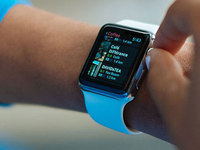Brits step up to wearable technology

It seems the nation is picking up the pace when it comes to wearable technology. Indeed, new research from market intelligence agency Mintel finds that over 3 million wrist-worn wearable devices such as fitness bands and smartwatches are estimated to have been sold in the UK in 2015, up 118% from unit sales in 2014 which reached 1.4 million.
Whilst smartwatch sales are set to soar in 2016, it was the fitness band which was the most bought wearable device last year, out-stripping sales of smartwatches by almost two to one. In 2015, 63% of wrist-worn wearable devices sold were fitness bands, compared to 37% which were smartwatches. However, highlighting the increasing popularity of smartwatches, in 2014 smartwatches accounted for just 9% of sales, compared to fitness bands which made up 91% of unit sales.
What’s more, currently the number of consumers intending to purchase a smartwatch is nearly on par with fitness bands. Almost one in 10 (9%) Brits say they plan to buy or upgrade to a new fitness band within the next 12 months, compared to 8% who say the same of smartwatches. But it seems that it is not new purchasers who are interested in investing in these devices as 40% of consumers planning on buying or upgrading a smartwatch or fitness band in the next year already own a wrist-worn wearable device.
Sara Ballaben, Technology Analyst at Mintel, said: “While fitness bands are, on average, less expensive than other wearables and have been on the market for relatively longer, higher adoption rates are also a reflection of the fact that wrist-worn devices offer a compelling practical benefit to active users. Fitness bands monitor and help to improve their performance while eliminating the need to carry around bulkier devices while training. While important product launches have and will certainly continue to accelerate consumer demand for smartwatches, the expected popularity of smartwatches in the short term is also the result of continued growth of the phablet market, which creates more compelling use cases for wrist-worn watches.”
Overall, currently around one in seven (14%) Brits own any wearable technology, with 7% owning a fitness band and 3% owning a smartwatch. Consumers aged 16-34 show the strongest interest in wearables, being about three times more likely than those aged 35+ to own a fitness band. Indeed, 13% of Brits aged 16-34 currently own a fitness band compared to 4% of those over age 35. What’s more, 6% of consumers aged 16-34 currently own a smartwatch, compared to just 1% of those over age 35.
Whilst Brits are looking to invest in wearable tech, it seems that by and large it is fashion over function that consumers may be buying into. When purchasing a new piece of wearable technology, appearance and design comes in as the third most important feature with 21% picking this attribute behind battery life (39%) and waterproof protection (22%). Indeed, appearance and design tops more functional features such as the accuracy and reliability of the measurements that the device tracks (19%) and compatibility with other devices (17%).
“As consumers value ‘wearability’ and prioritise personal style over more technological features, strengthening consumers’ perception of wearable technology as customisable personal accessories rather than ‘techy’ gadgets will be key to boosting adoption. Moreover, everyday experiences, from in-store try-outs and demonstrations to real-world applications at different locations, including shopping malls, airports, train stations, cinemas and entertainment parks, can help familiarise consumers with the benefits of wearables.” Sara continues.
Mintel research indicates that despite the growing popularity of wearable devices, there are common concerns about the technology shared by many consumers. Three in five (59%) consumers say they would worry about the security of their personal data if it was stored on a wearable device, whilst over half (51%) say they do not see how wearable devices could add value to their daily routine. What’s more, two in five (39%) say that wearable technology represents an invasion of one’s privacy.
Despite the fact that consumers pose privacy concerns for wearable technology, three in five (60%) consumers say they would be interested in receiving at least one type of information alert via wearable devices. However, Mintel research shows that the interest in the type of alerts received is diverse amongst consumers, as one quarter (26%) would be interested in receiving a weekly summary of their health status, and the same proportion (26%) would be interested in receiving incoming emails, texts, calls and calendar reminders. What’s more, 15% would be interested in being notified when friends or people they know are nearby.
“The gap between overall interest in receiving alerts through wearables and specific interest in each type of information alert suggests that there is significant variability among consumer preferences and no one-size-fits-all solution can be successful. As a result, it is fundamental that wearables do not overload users with information and, instead, filter selectively what information is disseminated. This suggests that customisation should go beyond a device’s design to allow users to personalise the use they make of their wearable, as well as the range and number of alerts they receive.” Sara concludes.

